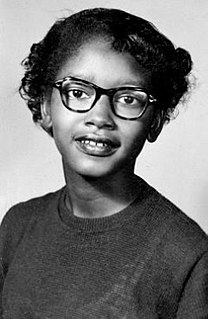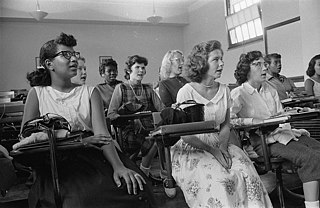
Thurgood Marshall was an American lawyer, serving as Associate Justice of the Supreme Court of the United States from October 1967 until October 1991. Marshall was the Court's 96th justice and its first African-American justice. Prior to his judicial service, he successfully argued several cases before the Supreme Court, including Brown v. Board of Education.

Brown v. Board of Education of Topeka, 347 U.S. 483 (1954), was a landmark decision of the U.S. Supreme Court in which the Court ruled that American state laws establishing racial segregation in public schools are unconstitutional, even if the segregated schools are otherwise equal in quality. Handed down on May 17, 1954, the Court's unanimous (9–0) decision stated that "separate educational facilities are inherently unequal," and therefore violate the Equal Protection Clause of the Fourteenth Amendment of the U.S. Constitution. However, the decision's 14 pages did not spell out any sort of method for ending racial segregation in schools, and the Court's second decision in Brown II only ordered states to desegregate "with all deliberate speed".
Milliken v. Bradley, 418 U.S. 717 (1974), was a significant United States Supreme Court case dealing with the planned desegregation busing of public school students across district lines among 53 school districts in metropolitan Detroit. It concerned the plans to integrate public schools in the United States following the Brown v. Board of Education (1954) decision.

Claudette Colvin is an American nurse and was a pioneer of the Civil Rights Movement. On March 2, 1955, she was arrested at the age of 15 in Montgomery, Alabama for refusing to give up her seat to a white woman on a crowded, segregated bus. Colvin acted a few months before the more widely known incident in which Rosa Parks, secretary of the local chapter of the NAACP, played the lead role, sparking the Montgomery Bus Boycott that began that year.

The Montgomery bus boycott was a political and social protest campaign against the policy of racial segregation on the public transit system of Montgomery, Alabama. It was a seminal event in the civil rights movement. The campaign lasted from December 5, 1955 — the Monday after Rosa Parks, an African-American woman, was arrested for refusing to surrender her seat to a white person — to December 20, 1956, when the federal ruling Browder v. Gayle took effect, and led to a United States Supreme Court decision that declared the Alabama and Montgomery laws that segregated buses were unconstitutional. Many important figures in the civil rights movement took part in the boycott, including Reverend Martin Luther King Jr. and Ralph Abernathy.
Buchanan v. Warley, 245 U.S. 60 (1916), is a case in which the Supreme Court of the United States addressed civil government-instituted racial segregation in residential areas. The Court held unanimously that a Louisville, Kentucky city ordinance prohibiting the sale of real property to blacks in white-majority neighborhoods or buildings and vice versa violated the Fourteenth Amendment's protections for freedom of contract. The ruling of the Kentucky Court of Appeals was thus reversed.
Desegregation busing in the United States is the practice of assigning and transporting students to schools so as to redress prior racial segregation of schools, or to overcome the effects of residential segregation on local school demographics.
Bolling v. Sharpe, 347 U.S. 497 (1954), is a landmark United States Supreme Court case in which the Court held that the Constitution prohibits segregated public schools in the District of Columbia. Originally argued on December 10–11, 1952, a year before Brown v. Board of Education, Bolling was reargued on December 8–9, 1953, and was unanimously decided on May 17, 1954, the same day as Brown. The Bolling decision was supplemented in 1955 with the second Brown opinion, which ordered desegregation "with all deliberate speed". In Bolling, the Court did not address school desegregation in the context of the Fourteenth Amendment's Equal Protection Clause, which applies only to the states, but rather held that school segregation was unconstitutional under the Due Process Clause of the Fifth Amendment to the United States Constitution. The Court observed that the Fifth Amendment to the United States Constitution lacked an Equal Protection Clause, as in the Fourteenth Amendment to the United States Constitution. The Court held, however, that the concepts of Equal Protection and Due Process are not mutually exclusive, establishing the reverse incorporation doctrine.
Browder v. Gayle, 142 F. Supp. 707 (1956), was a case heard before a three-judge panel of the United States District Court for the Middle District of Alabama on Montgomery and Alabama state bus segregation laws. The panel consisted of Middle District of Alabama Judge Frank Minis Johnson, Northern District of Alabama Judge Seybourn Harris Lynne, and Fifth Circuit Court of Appeals Judge Richard Rives. On June 5, 1956, the District Court ruled 2-1, with Lynne dissenting, that bus segregation is unconstitutional under the Equal Protection Clause of the 14th Amendment to the U.S. Constitution.
Murray v. Pearson was a Maryland Court of Appeals decision which found "the state has undertaken the function of education in the law, but has omitted students of one race from the only adequate provision made for it, and omitted them solely because of their color." On January 15, 1936, the court affirmed the lower court ruling which ordered the university to immediately integrate its student population, and therefore created a legal precedent making segregation in Maryland illegal.
Desegregation of the Baltimore City Public Schools took place in 1956 after the United States Supreme Court ruled, in the case of Brown v. Board of Education, that segregation in schools went against constitutional law. Desegregation of U.S. schools was part of the civil rights movement. The events that followed desegregation in Baltimore, were important to the civil rights movement across America. Recent scholarship has identified Baltimore's desegregation as an important precursor to the Greensboro sit-ins.
Bell v. Maryland, 378 U.S. 226 (1964), provided an opportunity for the Supreme Court of the United States to determine whether racial discrimination in the provision of public accommodations by a privately owned restaurant violated the Equal Protection and Due Process Clauses of the 14th Amendment to the United States Constitution. However, due to a supervening change in the state law, the Court vacated the judgment of the Maryland Court of Appeals and remanded the case to allow that court to determine whether the convictions for criminal trespass of twelve African American students should be dismissed.
Sarah Keys v. Carolina Coach Company, 64 MCC 769 (1955) is a landmark civil rights case in the United States in which the Interstate Commerce Commission, in response to a bus segregation complaint filed in 1953 by a Women's Army Corps (WAC) private named Sarah Louise Keys, broke with its historic adherence to the Plessy v. Ferguson separate but equal doctrine and interpreted the non-discrimination language of the Interstate Commerce Act as banning the segregation of black passengers in buses traveling across state lines.
Holmes v. Atlanta, 350 U.S. 879 (1955), was a per curiam order by the Supreme Court of the United States that summarily reversed an order by the Georgia Court of Appeals that permitted the city of Atlanta to allocate a municipal golf course to different races on different days. The case was remanded to the district court with directions to enter a decree in conformity with Mayor and City Council of Baltimore City v. Dawson.
Gregory v. Chicago, 394 U.S. 111 (1969), was a United States Supreme Court case in which the Court overturned the disorderly conduct charges against Dick Gregory and others for peaceful demonstrations in Chicago.

School integration in the United States is the process of ending race-based segregation within American public and private schools. Racial segregation in schools existed throughout most of American history and remains a relevant issue in discussions about modern education. During the Civil Rights Movement school integration became a priority, but since then de facto segregation has again become prevalent.
This is a timeline of the American civil rights movement, a nonviolent freedom movement to gain legal equality and the enforcement of constitutional rights for African Americans. The goals of the movement included securing equal protection under the law, ending legally established racial discrimination, and gaining equal access to public facilities, education reform, fair housing, and the ability to vote.
White America, Inc., was an organization founded in Pine Bluff, Arkansas, in February 1955. The organization was created following the desegregation of schools in Arkansas, to attempt to prevent "any attempts by Negroes to enter white schools" in the state. The group joined two other militant white supremacist organizations in September 1955 to attempt to intimidate the local school board of Hoxie to reverse its decision to integrate its schools.








